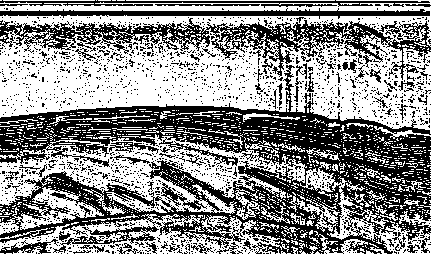In earthquake seismology and in laboratory measurement there are two clearly observed velocities. The faster velocity is a pressure wave (P-wave), and the slower velocity is a shear wave (S-wave). The shear wave can be polarized with ground motion in a horizontal plane (SH) or in a vertical plane (SV). Theory, field data, and laboratory measurement are in agreement. Successful experimental work with S-waves in the prospecting environment was done by Cherry and Waters [1968] and Erickson, Miller and Waters [1968].
It is remarkable that more than 99% of industrial petroleum prospecting ignores the existence of shear waves. Mathematically the earth is treated as if it were a liquid or a gas. The experimental work with shear waves used special equipment to generate and record vibration perpendicular to the survey line, i.e. SH-waves. The picture of the earth given by these transverse waves is often impaired by the soil layers, but sometimes the SH-wave picture is clear and consistent. Surprisingly, even good SH-wave data is often difficult to relate to the P-wave picture. These experimental studies show that the shear waves typically travel about half the speed of the pressure waves except in the soil layer, where the shear wave speed is often much slower and more variable. Observed shear waves usually have lower frequency than pressure waves. A shear wave with half the frequency and half the velocity of a pressure wave has just the same wavelength and hence the same resolving power as the pressure wave. Indeed, experimental work shows that shear waves do offer us about the same spatial resolution as pressure waves. Most land seismic data shows only the vertical component of motion, and all marine seismic data records the pressure. So in the conventional recording geometry, ideally we should never see SH-waves. More precisely, SH-waves should be small, arising only from the earth's departure from simple stratification.
The puzzling aspect of shear waves in reflection seismology is the failure
of petroleum prospectors
using the standard operating arrangement
to routinely observe
P-to-S conversions.
Theory predicts that P-waves hitting an
interface at an angle should be partially converted to SV-waves.
Furthermore,
for the 30![]() -60
-60![]() angle reflections that are routinely encountered,
these converted waves should have a size comparable to the P-wave.
angle reflections that are routinely encountered,
these converted waves should have a size comparable to the P-wave.
The routine geometry of recording and processing discriminates somewhat
against converted shear waves.
But it discriminates against multiple reflections too
(in much the same way)
and we see multiples all the time.
Furthermore the signature of converted waves
should resemble that of multiples, but be distinctly different.
Converted waves should show up routinely in velocity surveys
(chapter ![[*]](http://sepwww.stanford.edu/latex2html/cross_ref_motif.gif) ).
Figure 12 shows a zero-offset section
containing some multiple reflections.
The multiple reflection is recognizable as a replica
of earlier topography.
Converted waves would replicate the topography but the time scaling
would be in the ratio of about 3/2 instead of exactly 4/2.
With a sufficiently complex topography, as in Figure 12,
the probability is low that the converted wave
would be mistaken for another primary reflection.
).
Figure 12 shows a zero-offset section
containing some multiple reflections.
The multiple reflection is recognizable as a replica
of earlier topography.
Converted waves would replicate the topography but the time scaling
would be in the ratio of about 3/2 instead of exactly 4/2.
With a sufficiently complex topography, as in Figure 12,
the probability is low that the converted wave
would be mistaken for another primary reflection.
 |
Converted waves should have good diagnostic value in exploration. But the likelihood of seeing converted shear waves in conventional data seems to be so remote that most interpreters have given up looking. Why aren't converted waves seen in conventional data? Some reasons can be offered:
Of all the reasons why converted shear waves should be weaker than pressure waves, none is overwhelming. A wide range of amplitudes are recorded in a wide variety of environments. Data are often displayed with automatic gain control (AGC). Weakened amplitude appears to be insufficient cause for the failure of observation. We should keep looking. Converted waves are certainly more prevalent than our recognition of them. (I have never identified a converted shear wave on conventional recordings).
So although converted shear waves might some day play a significant role in reflection seismology, we now return to the mainstream--how to deal effectively with that which is routinely observable.